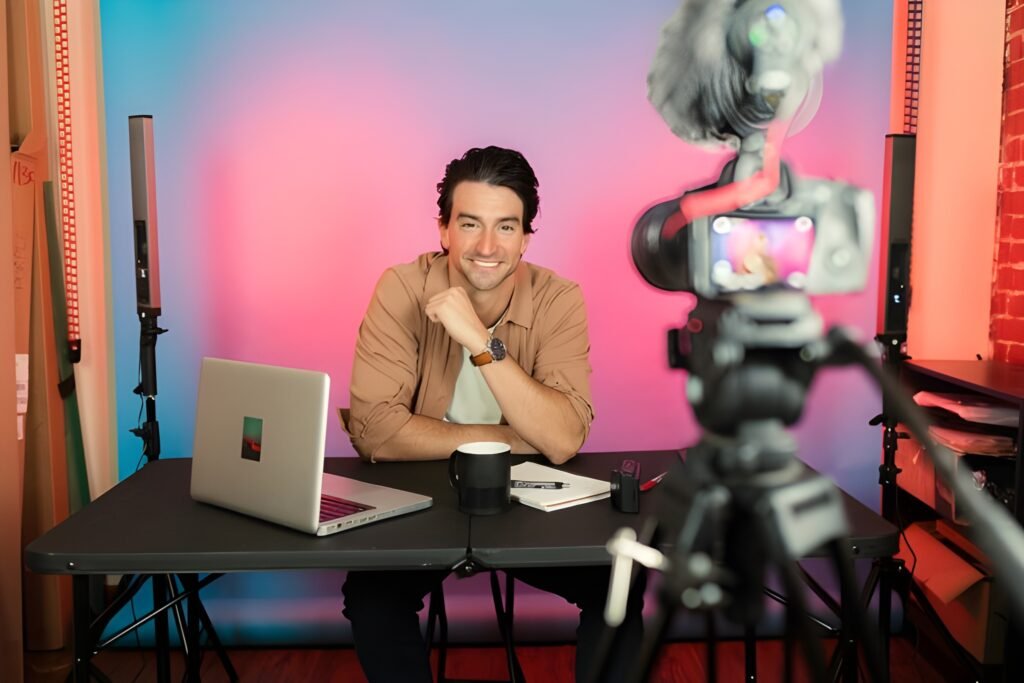How To Build Your LinkedIn Brand Without Compromising Who You Are, LinkedIn is the ultimate platform for digital marketers looking to build authority, grow their network, and attract high-quality leads. Unlike other social media platforms, LinkedIn prioritizes professional relationships, making it an ideal space to position yourself as an expert in your industry.
By the end of this guide, you’ll have a clear, actionable roadmap for building a LinkedIn brand that aligns with your personality, values, and business goals.
- What is LinkedIn Marketing?
- Defining Your Authentic LinkedIn Brand
- Crafting an Engaging LinkedIn Profile
- Content Strategy That Feels Natural
- Balancing Personal & Professional Content
- Content That Builds Your Brand Without Being Fake
- How to Pick Your Core Content Themes?
- How to Balance Storytelling and Educational Content?
- How to Write Like You Talk?
- Conclusion
What is LinkedIn Marketing?

Many digital marketers hesitate to post on LinkedIn because they don’t want to sound overly promotional, robotic, or like everyone else. The fear of being judged or coming across as “salesy” holds them back.
The good news? You don’t have to compromise who you are to build a strong LinkedIn presence. Instead, you can leverage your authentic voice, unique experiences, and genuine insights to create a brand that attracts the right audience—without feeling like you’re putting on a show.
Defining Your Authentic LinkedIn Brand
Building a LinkedIn brand that feels natural starts with clarity—clarity about who you are, what you stand for, and how you want to be perceived. If you don’t define your brand, LinkedIn’strends and engagement-driven culture can easily pull you in a direction that doesn’t align with you.
Understanding Your Core Values
Your values define your brand. They dictate how you communicate, the type of content youpost, and how you engage with others. If you feel uncomfortable with your LinkedIn presence, it’s likely because you’re posting in a way that doesn’t align with your true values.
Exercise: Identifying Your Core Values
Take a few minutes to answer these questions:
What are the top 3-5 values that guide you in your work? (Examples: authenticity, integrity, innovation, service, transparency, creativity).
- What do you want to be known for on LinkedIn?
- What types of content feel natural for you to share?
- What topics do you enjoy talking about, even if they don’t “perform” well?
Your answers will serve as a filter for everything you do on LinkedIn. If something doesn’t align with your values, you can confidently ignore it—no matter how trendy it is.
Identifying Your Unique Positioning

You don’t need to be the best digital marketer on LinkedIn—you just need to be the right choice for the right people. The key to standing out is specificity.
Find Your “Authenticity Niche”
Instead of saying, “I help businesses with digital marketing,” get more specific:



Your niche doesn’t have to be hyper-focused, but it should be clear enough that people immediately understand what you bring to the table.
Exercise: Define Your Positioning in One Sentence
Fill in the blanks:
> “I help [target audience] achieve [specific result] through **[your unique approach].”
Example:
> “I help digital marketers generate inbound leads by using LinkedIn comments strategically.”
This statement will guide your content, networking, and messaging on LinkedIn.
Setting Personal Boundaries for Branding
One of the biggest fears people have about personal branding is oversharing or feeling like they have to put their entire life online. The truth is, you don’t have to share everything—you just need to be consistent in what you do share.
Decide What You Will and Won’t Share


For example, if privacy is important to you, you might decide to share business lessons from your journey but avoid talking about personal relationships. If you value transparency, you might be open about business struggles but still keep certain details private.
Authenticity doesn’t mean sharing everything—it means sharing what aligns with your values.
Crafting an Engaging LinkedIn Profile

Your LinkedIn profile is your personal landing page. Before someone engages with your content or accepts your connection request, they’ll check your profile. If it’s unclear, generic, or uninspiring, you’ll miss out on valuable opportunities.
A strong profile isn’t just about looking professional—it should tell your story, reflect your expertise, and attract the right audience.
Writing a Profile That Reflects Your True Self
Many digital marketers make the mistake of treating their profile like a resume instead of a personal brand statement.
Your LinkedIn profile should communicate three things:



A compelling profile makes people think:
> “This is exactly the kind of person I want to follow or work with.
To achieve this, let’s optimize each section step by step.
Headline & About Section Optimization
Crafting a Headline That Stands Out Your headline is the first thing people see on your profile. Instead of just listing your job title, make it compelling.
Formula for an Effective Headline:
> [What you do] + [Who you help] + [Unique value proposition]
Examples of High-Impact Headlines:




Writing an About Section That Feels Personal & Persuasive Your About section is your chance to tell your story. It shouldn’t feel robotic or overly formal. Instead, write it as if you’re having a conversation.
Simple Formula for an Engaging About Section:
- Start with a hook – A relatable statement or question that grabs attention.
- Tell your story – Share how you got into digital marketing and what drives you.
- Explain who you help & how – Clearly define your audience and your unique approach.
- Provide social proof – Mention results, testimonials, or achievements.
- End with a call-to-action (CTA) – Encourage visitors to connect, message, or check out your content.
Example of an Authentic About Section:
> “Most people think digital marketing is all about running ads and chasing algorithms. But I believe in a different approach—one that’s based on authenticity, human connection, and content that actually provides value.
I started my journey in digital marketing by [brief personal story]. After working with [Xnumber] of businesses, I realized that most struggle with [common pain point]. That’s where I come in.
Today, I help [specific audience] generate leads organically using [your approach]. My focus is on [your core values], and I believe in [your mission].
Want to learn more? Let’s connect, or check out my posts where I share insights on [topic].”
This makes your About section feel natural and engaging, rather than a corporate bio.
Profile Picture & Banner Strategy
Your visuals play a key role in building trust and credibility on LinkedIn.
Choosing a Profile Picture That Feels Authentic:




Your photo should reflect the vibe you want people to associate with your brand. If you’reacasual, approachable marketer, you don’t need a corporate headshot—just a clean, professional image that feels like “you.”
Optimizing Your LinkedIn Banner, Most people ignore their banner, but it’s a valuable branding space. Instead of using a generic cityscape or leaving it blank, make it work for you.
Elements of an Effective Banner:




Example of a Strong LinkedIn Banner:
Text: “Helping Coaches & Consultants Build a Personal Brand That Attracts Clients”
Image: Your photo + a subtle background design
CTA: “Let’s Connect”
You can create a professional-looking banner using Canva or hire a designer for a customer.
Content Strategy That Feels Natural

Posting on LinkedIn doesn’t have to feel forced or robotic. The key is to create content that aligns with your personality, values, and expertise while still engaging your audience.
If you’ve ever thought:
- “I don’t know what to post.”
- “I don’t want to sound like everyone else.”
- “I don’t want to share things that feel fake.”
Then this section will help you craft a content strategy that feels authentic and still drives engagement.
Types of Posts That Work Without Feeling Forced
You don’t need to follow every LinkedIn trend to get engagement. Instead, focus on posting in a way that feels natural to you.
Here are five high-performing post types that work while staying true to your voice:
1. Personal Stories with a Business Lesson


A mistake you made and what you learned.
A challenge in your career and how you overcame it.
A surprising lesson from a client or project.
Example Post:
> “When I started my digital marketing journey, I made a huge mistake—I focused too much on vanity metrics instead of real engagement.
It wasn’t until I shifted my strategy that I started attracting high-ticket clients instead of just likes and comments.
2. Industry Insights & Trends (But With Your Unique Take)


A common myth in digital marketing.
A new trend and whether it’s worth paying attention to Your honest take on LinkedIn strategies that don’t work.
Example Post:
> “Everyone says you need to post every day to grow on LinkedIn. I disagree. What actually matters is consistency and quality, not just frequency.
3. Actionable How-To Posts & Mini-Guides


A step-by-step strategy for lead generation.
A case study on how you helped a client.
A list of tools you use for digital marketing.
Example Post:
> “Want to turn your LinkedIn comments into high-ticket leads?
Here’s my simple 3-step process: [Share actionable steps].”
4. Thought-Provoking Questions


“What’s the worst marketing advice you’ve ever received?”
“If you could give one LinkedIn tip to a beginner, what would it be?”
“What’s the biggest challenge in digital marketing right now?”
Example Post:
> “If LinkedIn removed the ‘Like’ button, how would that change the way you post?”
This invites engagement without forcing it.
5. Behind-the-Scenes & “Unfiltered” Moments


A work-in-progress project.
A mistake you made and how you fixed it.
A behind-the-scenes look at your workflow.
Example Post:
> “Here’s what my content calendar looked like last year vs. this year. What changed? I stopped trying to be perfect and focused on being useful.”
Balancing Personal & Professional Content

One common struggle is knowing how much personal vs. professional content to share.
Here’s a simple rule of thumb:


If you’re naturally more reserved, you don’t have to share deeply personal stories. Instead, find balance that works for you.
Examples of Personal-Professional Balance:
- Instead of “Here’s my life story,” try: “Here’s a challenge I faced in my business and howI overcame it.”
- Instead of “Here’s my morning routine,” try: “Here’s how I structure my day for better productivity.”
- The key is relevance. If your personal story ties into a lesson for your audience, it will feel authentic.
Authentic Storytelling Without Overthinking
Many people struggle with overthinking their LinkedIn posts. Here’s how to make storytelling feel more natural:
Use the “Hook, Story, Lesson” Formula
This simple framework makes any post engaging:
- > Hook: A strong opening line that grabs attention.
- Story: The main event (personal experience, case study, or insight)
- Lesson: A takeaway that provides value to your audience.
Example:

> “Here are three tips for personal branding.” (Boring, generic)

> “I used to think personal branding was about being everywhere. I was wrong.
When I first started, I posted constantly but got zero leads. It wasn’t until I changed my approach that I started attracting high-quality clients.
Speak Like a Human (Not a Corporate Robot)


Example:


People connect with real, conversational language, not corporate-speak.
Creating a Content Plan That Feels Sustainable
If posting on LinkedIn feels overwhelming, simplify it with a lightweight content system.
Here’s a 3-step weekly content plan that won’t burn you out:



This keeps your presence consistent without feeling like a full-time job.
Content That Builds Your Brand Without Being Fake

Content is the lifeblood of your LinkedIn brand. It’s how people get to know you, trust you, and see your expertise in action. But here’s the challenge: How do you create LinkedIn content that builds your brand without sounding fake, pushy, or robotic?
Many digital marketers struggle with this. They either:
- Over-promote themselves and come across as salesy.
- Try to be someone they’re not because they think they need to sound like an “influencer.”
- Struggle with consistency because they’re unsure what to post.
This section will help you create content that feels natural, resonates with your audience, and strengthens your LinkedIn brand—without compromising who you are.
Choosing Content Themes That Align With Your Expertise
Your content should revolve around a few core themes that align with your expertise, values, and the problems you help solve. Instead of posting random thoughts, structured help:
- Position you as an authority in your niche.
- Make content creation easier by giving you clear topics to focus on.
- Attract the right audience who find your insights valuable.
How to Pick Your Core Content Themes?

Use this simple framework to define your themes:
1. What are you known for (or want to be known for)?
Example: LinkedIn marketing, email marketing, paid ads, brand strategy.
2. What unique perspectives do you have?
Example: “I believe cold outreach is dead—here’s what works instead.”
3. What common problems does your audience face?
Example: “Why your LinkedIn posts aren’t getting engagement (and how to fix them).”
4. What personal experiences shaped your expertise?
Example: “How I went from struggling to get clients to closing 5-figure deals using LinkedIn.”
Example of Content Themes for a Digital Marketer
If you’re a LinkedIn marketing expert, your themes might look like this:
- LinkedIn growth strategies (how to grow an engaged audience)
- Lead generation without being spammy (authentic networking, inbound leads)
- Personal branding on LinkedIn (how to stand out without faking it)
- Lessons from your journey (failures, wins, and real-life experiences)
- Industry trends and hot takes (your opinion on what’s changing in digital marketing)
How to Balance Storytelling and Educational Content?
A good content strategy includes both storytelling and educational posts:
Use the HERO framework for storytelling posts:
H: Hook (grab attention with an intriguing first sentence)
E: Emotion (describe the challenge or struggle)
R: Resolution (how you solved it)
O: Outcome (the lesson or takeaway)
Example:


How to Write Like You Talk?

One of the biggest mistakes digital marketers make? Writing like a corporate robot. LinkedIn posts that sound too polished or salesy feel inauthentic. Instead, write the way you actually talk.
Tips to Make Your Writing More Natural:
1. Use simple language (no jargon or buzzwords).
2. Write short sentences (easier to read).
3. Break up text (avoid long paragraphs—use spacing).
4. Use contractions (e.g., “I’m” instead of “I am”).
5. Inject personality (add humor, quirks, or unique perspectives).
Example: Before & After

“To achieve optimal engagement on LinkedIn, it is imperative to construct content that resonates with your audience and drives maximum impact.”

“Struggling to get engagement on LinkedIn? I’ve been there. Here’s what actually works (and what doesn’t).”
Engaging Formats: Text Posts, Carousels, and Videos
LinkedIn offers multiple content formats. The key is using the right ones without forcing yourself into a style that doesn’t fit you.
1. Text Posts (Best for Personal Stories & Insights)
Use for: Short, engaging posts (e.g., lessons, experiences, thought leadership).
Tip: The first 2 lines should hook the reader—most people only see the preview.
2. Carousel Posts (Best for Step-by-Step Guides & Lists)
Use for: Teaching something in an easy-to-digest format.
Tip: Keep slides visually clean and include a strong CTA on the last slide.
3. Video Content (Best for Building Personal Connection)
Use for: Showcasing personality, behind-the-scenes, client testimonials.
Tip: Keep it short (under 90 seconds) and add captions (most people watch on mute).
4. Structuring Your Content Calendar for Consistency
Creating great content is one thing—staying consistent is another. Many people start strong, then burn out because they don’t have a system.
Simple LinkedIn Content Calendar (3-Post Per Week Strategy). This structure keeps you visible without overwhelming you.
Conclusion
Building a strong LinkedIn brand in digital marketing doesn’t mean you have to be fake, overly polished, or constantly selling. Instead, it’s about showing up authentically, sharing real value, and building meaningful connections-without feeling like you’re playing a role.
In this guide, we’ve broken down how to grow your LinkedIn presence while staying true to yourself.


